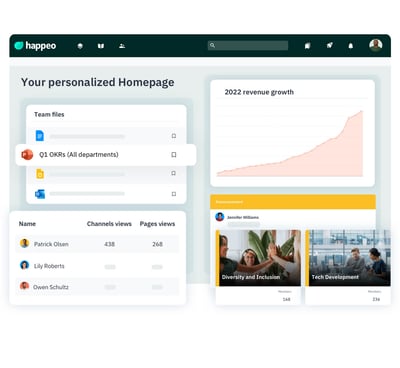
Quick guides Knowledge Management
13 steps to create an effective knowledge management strategy

12 mins read
Start building your digital home with Happeo
Request a demoQuick guides Knowledge Management
Product
Features
Solutions
Happeo for
Use cases
Resources
Explore
Support
Happeo For
Use cases
Comparisons
Explore
Support
Recent

Jonathan Davies
12 mins read
You may be unaware, but your organization could be sitting on a hidden treasure trove. "Knowledge is power," said Sir Francis Bacon, but failing to share that wealth of information could be costing you thousands of dollars in lost revenue.
According to the Panopto Workplace Knowledge and Productivity Report, the average large US business loses $47 million in productivity each year due to inefficient knowledge sharing. Put another way – your employees could be wasting over 5 hours every week waiting for vital information they need to do their jobs.
If that sounds alarming, then it’s time to address the problem by creating an effective knowledge management strategy that shares your employees’ wealth of knowledge, empowers better decision-making, and boosts productivity.
In this guide, you’ll discover what a knowledge management strategy is, why you need one, and how to develop an effective strategy for your organization.
A knowledge management (KM) strategy is a comprehensive plan outlining how your organization will manage information, data, and knowledge to enhance productivity and efficiency. Successful KM strategies align closely with departmental and company-wide objectives and keep your KM team focused on your business priorities and needs.
Businesses that invest in a knowledge management strategy enable their teams to leverage shared knowledge and make informed decisions that impact innovation, revenue, and retention.
Developing a clear and effective knowledge management strategy lets you:
There are five core components of a knowledge management strategy: People, Processes, Content, Culture, and Technology. Let’s examine each one in turn:

People, rather than Technology, are the most important part of your strategy. If you fail at this stage, nobody will be interested.
Understanding the makeup of your staff, their communication patterns and preferences, along with what information they need, is vital.
So, here are some essential questions to ask to ensure you accommodate the needs and preferences of your employees:
Information drives organizational processes. Each step has an input and output, such as an email or a document. Therefore you need to analyze your processes when developing your KM strategy. Some of these processes may not be documented, so it’s important to dig below the surface.
Consider the following:
As well as understanding your organizational processes, it’s essential to analyze the content to identify gaps, stale content, potential security risks, plus missing or deficient processes.
When analyzing your content, consider the following:
The company culture shapes employees' attitudes and behaviors toward capturing, managing and sharing information. For instance:
Now you have a thorough understanding of the people, processes, content, and culture of your organization, you can explore the current technology stack. It’s vital to get a comprehensive understanding of all the existing systems, their functionality and restrictions, plus their lifecycle status.
Consider the following questions:
While every organization is unique, there are some common best practices that can help you develop an effective knowledge management strategy.
The first step in developing an effective knowledge management strategy is establishing your team. You need people who understand and value knowledge management since they’ll become role models and influencers when it’s time to roll out the KM system to the rest of your organization.
It’s essential to complete a knowledge audit to benchmark your organization’s current KM capabilities and identify the actions required to develop a successful KM strategy in your organization.
You’ll need to:
Before you go any further, it’s essential to build a business case to get senior management buy-in and investment for the implementation. The knowledge audit should provide all the information you need to create a solid business case and show how a knowledge management system could transform your organization.
Next, it’s time to select a knowledge management tool that will become the central hub for all of your company’s knowledge. You’ll need something that makes it easy for everyone to store and retrieve information.
Depending on the size and age of your organization, you can choose from the following types of systems to support your knowledge management strategy:
Before reviewing tools, create a checklist of the key features you need to align with your business needs.
When all the pieces are in place, you can develop your knowledge strategy implementation roadmap. The roadmap should describe the overall picture of your implementation, divided into stages, plus your objectives, milestones, and timelines. Clearly explain each step so that stakeholders understand how to create and share knowledge.
As you amass more and more knowledge for your company, you must have a method of retrieving specific information quickly.
Segmenting your knowledge management system makes it easier to navigate and organize resources in a way that makes sense for your staff.
Typically, knowledge management software lets you create spaces for projects, teams, or groups of documentation. It makes it easy for people to pinpoint the information they want and prevents information overload. Segmentation is ideal for help desks, as it speeds up the process of finding the answer a customer is looking for.
Search is a significant part of your knowledge management strategy. But you need to make a conscious effort to make it really work in your favor.
If you want to make search work, you need to train everyone to embrace proper archiving standards. That means, every time someone uploads a file or document to your knowledge management system, they need to tag it with specific search terms.
For example, Happeo's powerful Universal Search feature gives your employees the ability to search across departments and quickly find the knowledge they need.

Image: Happeo provides a unified search experience where users can access several internal and external information sources from a single interface, including content from your intranet’s Channels, Pages and People.
Employees can also access shared and private information from connected workspaces such as Google Drive and Microsoft Sharepoint.
Ensure your employees create content for your knowledge management system consistently by developing a well-defined content framework. You can establish rules on who can add new or update existing content in your knowledge segments.
If you don’t have a content framework, your entire knowledge management repository will become outdated with inaccurate and obsolete information and cluttered with unnecessary documentation.
The more segmented your information, the faster employees can find what they’re looking for, such as searching for employees with expertise in another area. An employee directory identifies your subject matter experts in areas and fields and makes them more accessible to others.
With Happeo’s Employee Directory, you can connect your people in various ways:
One of the best ways to keep employees using your knowledge management system is to ensure they only see the information required to do their jobs. Anything else becomes a distraction and a nuisance.

For example, Happeo’s Personalized Homepage allows you to create a custom company homepage with relevant dynamic content specific to each user, role, and function.
As well as housing company information, knowledge management systems are social networks. You can encourage staff to create, share, and curate content based on their skills and experience.
For example, Happeo’s Collaborative Channels allow your employees to collaborate on projects, connect with colleagues, and share news. You can post messages, share files, like, comment, tag users, and share content.
One of the benefits of modern knowledge management systems is that you can bring in content from existing workspaces, such as Google Workspace, Microsoft 365, and other 3rd party tools. Everything is centralized in a single, searchable location. It saves time and increases productivity since users can quickly find resources and collaborate with other team members without having to leave the platform to track down an important file.
Finally, it’s essential to track what content users search for and engage with. Based on these insights, you can create more topics that resonate.
With Happeo’s Advanced Analytics, you can see exactly what employees want to talk about in Channels, which posts get the most interaction, and who is the biggest influencer/contributor in your organization.

Search Analytics shows you:
A successful knowledge management (KM) strategy aligns closely with your business objectives. It details how your organization will manage its information and data, so that you can give everyone equal access to vital knowledge, make better-informed decisions, and improve overall productivity.
Your knowledge management strategy should contain five core components – People, Processes, Content, Culture, and Technology – with your people being the most important aspect.
Happeo’s knowledge management system makes it easy for your organization to find, share and retain knowledge. It provides a single source of truth for everyone, encourages users to collaborate and communicate, and allows you to analyze and optimize your content. Watch a free demo today!
